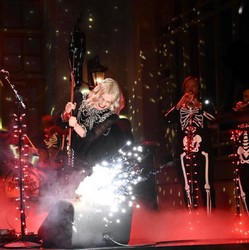 Upon walking in on the “Massachusetts” art exhibit in Joan and Robert Rechnitz Hall, you’ll be greeted by a wide array of art styles. Some paintings are dark and ominous, others are surreal, depicting reality in supernatural ways. Despite differences, each piece invokes you to come closer for further inspection. The exhibit is a combination of works from nine artists in total, each bringing their unique flavor to the Vincent DiMattio Gallery. DiMattio is also a professor of art at the University.
Upon walking in on the “Massachusetts” art exhibit in Joan and Robert Rechnitz Hall, you’ll be greeted by a wide array of art styles. Some paintings are dark and ominous, others are surreal, depicting reality in supernatural ways. Despite differences, each piece invokes you to come closer for further inspection. The exhibit is a combination of works from nine artists in total, each bringing their unique flavor to the Vincent DiMattio Gallery. DiMattio is also a professor of art at the University.
The commonality that brings these pieces together isn’t found within the art itself, but within each contributor’s relationship to the state of Massachusetts. All but one of the artists graduated from Massachusetts College of Art during the mid 1960s. The other received a Master of Fine Arts degree from Boston University. After graduating, most of the artists went their separate ways. Regardless of the path they chose, they all found success in the arts. This special class has reunited to showcase their works to the public.
One of the first artists’ works you’ll be greeted by is Enrico Pinardi. His paintings lure you in with a sense of familiarity, but you’ll notice something strange: a plate floating slightly off the table, a shadowy figure in the background or a cracked floor underneath a clean white table. It seems as if the paintings are trying their best to show you that everything is fine, but instead reveal that something is missing.
In the painting “Night Games,” Pinardi combines the good natured fun of darts, dice and cards with the seriousness of a frayed rope. This stark contrast reveals some people’s attitude toward lynching: it was just a thing to do on an uneventful night. His sculptures also depict this feeling of oppression. The figures are hunched over, as if their backs are warped from carrying so much weight on their shoulders.
A stark contrast to Pinardi, Candance Walters’ contributions are colorful and bright. In “Where the Fate Leads Us,” Walters drew inspiration from her travels to create what feels like a living scrapbook. Postcards and souvenirs are peppered throughout her piece. Unlike Pinardi, Walters seems to be more interested in reflecting than making a statement. Her works are beautiful for the sake of being beautiful, instead of worrying too much about what they are trying to say.
Adjacent to Walter’s are the works of Steve Smalley. Smalley uses “There Are No Places Like Home” and “My First School” to largely reminisce on his childhood. Both contain a large amount of empty space but contain a handful of childhood symbols: a jungle gym, Mighty Mouse, baseball cards. When you are young, only a few things truly capture your attention and Smalley’s paintings embody this childlike perspective perfectly.
Towards the center of the exhibit rests the surrealist paintings of Brenda Atwood. Two of her paintings, “Moonchild” and “Rings of Fire” play off of each other well. “Moonchild” is about embracing the comforts of nature. A lone woman is depicted embracing herself among a flock of large red birds. The birds seem to acknowledge the woman’s presence but aren’t looking at her. Instead, they seem to be on the lookout for potential threats, possibly those depicted in “Rings of Fire.”
In this painting, the protagonists find themselves surrounded by humanoids instead of animals. These human-like monsters have bent the women to their will by forcing them to jump through fiery hoops as they watch in amusement. In the corner of the picture, others watch this grave injustice taking place but do nothing. Atwood makes the statement that nature is accepting and comforting in “Moonchild.” It is beyond nature’s ability to judge. In “Rings of Fire,” Atwood depicts how society forces us to conform.
Suzanne Howes-Stevens chose to let nature do the talking for her. The inspiration for her paintings was from her travels through wetlands in a canoe. They often depict the meeting of land and water, such as a swamp or a lake in the middle of a forest. Her paintings are calm, welcoming and stray from using overtly dark or light colors. The paintings themselves are gorgeous, and the fact that they exists somewhere makes them even more magical.
Scattered around the exhibit are the terracotta statues of John Stevens. Stevens takes inspiration from people’s affections for cats. Most of his sculptures depict a person who seems to be overwhelmed by felines. It is almost as if they are being controlled by the natural allure of the cat. They look like they want to get up, but are worried about disturbing the cats: a common predicament for any cat owner.
Upstairs are the works of Robert Stein, and Robert Cumming, and DiMattio. DiMattio’s “Ancient Walls” series look like something you would perhaps see in a cave painting. He uses bright colors and uniquely crafted characters that result in a painting that is not only eye-catching, but mysterious as well.
Robert Stein has the most interesting showcase. One of his works “Low Tolerance Product,” consists of a plain picture of himself, digitally modified to give off a purple hue with the title “Low Tolerance Product” in a small box on the bottom. Throughout his work, Stein makes use of symbols for a wheelchair and a baby bottle, perhaps signaling he is caught in the middle of the young and old stages of life. Out of the exhibit, his pieces are the least traditional. His works aren’t grounded in nature, and it is tough to decipher the meaning of each work. While his paintings induce the most head scratching, they will also be the paintings most discussed.
Then there is the work of Robert Cumming. At first glance, one may be tempted to look away from his pieces. However, they will be missing out on a powerful lesson. Cumming chose to work with live models to create his drawings for the exhibit. His paintings depict nude older women, often in positions that reveal everything. The women radiate confidence and pride. The models were not self-conscious, even if they aren’t what society classifies as beautiful. The truth is everyone is naked, but some of us still try to cover ourselves up. Cumming’s portraits say no to that notion. Do not hide who you are. You would only be doing yourself and this world an injustice.
As a whole, the exhibit can be overwhelming. You may be initially attracted to the bright colors of Waters’ work, only to get to the feeling that someone is watching you, courtesy of Pinardi’s display. Each work needs to be viewed separately. This isn’t a collaborative exhibit. Instead, it’s a celebration of the careers of nine fantastic artists, each of which deserve attention.
The exhibit was revealed Sept. 3 and will be available until Dec. 5. Admission is free.
PHOTO TAKEN from facebook.com/Monmouth-University-Department-of-Art-and-Design



